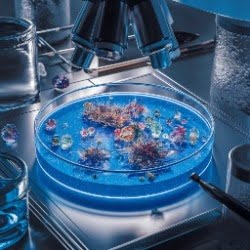A unique microbiological growing medium called Bismuth Sulphite Agar (BSA) was developed specifically for the selective isolation and differentiation of Salmonella species, especially Salmonella Typhi and Salmonella Paratyphi. BSA was created for use in food, environmental, and clinical microbiology. It is essential for detecting these pathogens from a range of samples.

Table of Contents
Composition of Bismuth Sulphite Agar (BSA)
A selective medium called bismuth sulphite agar is mainly used to isolate Salmonella species, especially Typhi and Paratyphi. The following makes up one liter of distilled water on average
The typical composition per liter of distilled water is as follows
- Peptone: five grams
- 5.0 grams of dextrose (glucose)
- 4.0 grams of disodium phosphate
- 0.3 g of ferrous sulphate
- Indicator for Bismuth Sulfite: 8.0 g; Brilliant Green: 0.025 g
- Agar: 20 g
- One litre of distilled water
Principle of Bismuth Sulphite Agar (BSA)
By preventing the development of gram-positive and many other gram-negative bacteria, Bismuth Sulphite Agar is intended to identify Salmonella species with specificity. The following mechanisms are employed to attain the desired selectivity:
1. Bismuth Sulphite: It functions as a differential and selective agent. Gram-positive and many non-Salmonella gram-negative bacteria are inhibited by bismuth ions. When hydrogen sulfide combines with the iron ions in the media, salmonella converts sulphite to hydrogen sulfide, which results in black or brownish-black colonies.
2. Brilliant Green: It increases the medium’s selectivity by further inhibiting gram-positive and many gram-negative microorganisms.
3. Ferrous sulfate: It forms a black precipitate when it combines with the hydrogen sulfide that Salmonella produces, aiding in the colonies’ visual identification.
4. Dextrose: It provides a source of carbohydrates for the development of bacteria.
Preparation of Bismuth Sulphite Agar (BSA)
- Mix the Ingredients: Mix one liter of distilled water with the dehydrated medium. Bring to a boil while stirring often to ensure the medium dissolves thoroughly.
- Sterilization: Autoclave for 15 minutes at 121°C to achieve sterilization. Once sterilized, let the medium cool to 50 degrees.
- Fill Plates: Fill sterile Petri dishes with the medium. Before using, let them to dry and firm.
- Adjust the pH such that, at 25°C, the medium’s ultimate pH is between 7.5 and 7.7.
Results Interpretation of Bismuth Sulphite Agar (BSA)
- Salmonella Typhi/Paratyphi: The generation of hydrogen sulfide causes colonies to look black or brownish-black.
- Non-Salmonella Organisms: The presence of brilliant green and bismuth sulphite might impede colonies or cause them to seem green or colorless. Colonies often do not appear black.
- Lactose Fermenters: The medium usually inhibits them.
Uses of Bismuth Sulphite Agar
- Salmonella Isolation: This process is primarily used to separate Salmonella species from environmental, food, and clinical samples.
- Identification: Based on colony morphology, aids in the first identification of Salmonella.
- Screening: A method used in food safety and public health laboratories to check samples for Salmonella.
Limitations of Bismuth Sulphite Agar
- Selective Pressure: Although extremely selective, certain Salmonella strains could not cause the usual hydrogen sulfide reactions, which could result in misleading negative results.
- Competitive Flora: In highly polluted samples, Salmonella growth may be inhibited by the overgrowth of competing flora.
- Confirmatory testing: For precise identification, biochemical and serological testing should always be performed on presumed colonies.
Conclusion
A useful technique in microbiology for the selective isolation and tentative identification of Salmonella species is bismuth sulphite agar. In clinical and food microbiology laboratories, proper preparation, comprehension of its concepts, and accurate interpretation of data are essential for successful utilization.
Frequently Asked Question
1. What is the use of BSA agar?
Goal:
For the selective isolation and first identification of Salmonella Typhi and other Salmonellae from pathological materials, sewage, water sources, food, etc., Bismuth Sulphite Agar is advised.
2. What does BSA mean agar?
Gram-positive and gram-negative bacteria in the colon are inhibited by brilliant green and bismuth sulfite indicator. Hydrogen sulfide formation may be detected with the use of ferrous sulfate. Bismuth Sulphite Agar may be directly inoculated using clinical samples.
3. How to prepare BSA agar?
A common technique medium used in laboratories and industrial settings is bismuth sulfite agar. Salmonella species. 52 g of the medium should be suspended in one liter of distilled water. Stirring often, heat until it boils for one minute.
4. Why is BSA used?
In labs, BSA is frequently added to biochemical and tissue culture media as a supplement. In addition to stabilizing the amount of extracellular fluid, the protein transports tiny molecules including thyroid hormones, fatty acids, and steroids.
Related Article

